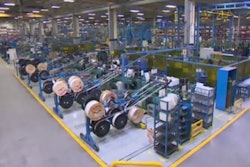In manufacturing, machine failure and unplanned downtime can be exceptionally costly. Efficiency becomes the name of the game, and that’s where iQagent comes in. Through the creation of an augmented reality system that connects the entire plant floor, manufacturers are able to increase efficiency and ROI when dealing with machine failures. To explain this new system, Bob Meads, the CEO of iQuest, took the time to answer some of IMPO’s most pressing questions.
IMPO: Can you explain iQagent and what it does for manufacturers?
Bob Meads: For some background you have to start with the company iQuest. Basically, iQuest is a seventeen year old automation provider which means, we go into manufacturing plants and provide automation solutions, such as programing robots and building manufacturing lines. Our partner, Kepware, is a data provider for plants and makes it easier to get data out of virtually any machine on the plant floor.
Being on the plant floor for as long as we have, we have noticed some very common problems that occur. It wasn’t just about getting data, but the problem that we saw was that you can get data about the equipment in every place except where you needed it most — right in front of the equipment.
People out on the plant floor are usually tasked with maintaining equipment or repairing equipment, especially when the production line goes down. And what we saw was that people would be at the equipment and they would have to leave to get the schematics or to go the control room to get a read out of the data so they could trouble shoot the problem. What iQagent does is recognize the equipment or machinery on the plant floor and provide you with all the relevant information on a mobile device so that the data can be provided in real time.
IMPO: How does this effect efficiency on the plant floor?
BM: It greatly improves it. The good thing about iQagent, efficiency and the ROI is that it is immediately calculable. Usually when I’m talking with a customer I’ll ask them three questions. First, for your average maintenance worker or engineer, how much of their day is spent with their back to the equipment? Meaning how often and for how long do they need to walk away from the machines to retrieve data, schematics, etc. that are necessary to fixing the machine. Typically that is about 30 to 40 minutes per person. The second question, is how many people do you have? The third question is what is the average salary?
Then, if you multiply these together, your ROI for a medium plant of about 100 people is about $100,000. So you are getting ROI every day. Improved efficiency comes from the fact that we completely eliminate the need for employees to turn their back on equipment to retrieve necessary resources. We make it all available immediately right there on their mobile device.
IMPO: What are some of the main benefits a manufacturer can expect to see by implementing iQagent?
BM: There are two benefits. First is the software and immediate access to data. Typically, a technician will go out to the floor, will identify a piece of equipment that is broken, then turn around to go get the schematics or look up the necessary data — and has now been gone for 30 to 40 minutes. With iQagent a worker can just hold up a tablet or device running the program that will recognize where he is at and show what is needed for the machine. We have then saved that amount of time, every time an employee goes out onto the plant floor to perform one of these maintenance activities.
The second problem that we solve is about communicating process down time issues. If a production line goes down and it is not supposed to, this cost is usually calculated in the hundreds of dollars per minute. It can even be more. The people operating the equipment are not engineers and are not maintenance people, so all the time that they have to spend calling a qualified worker or a remote location, they have to wait. Meanwhile, production is still down and the facility is spending significant amounts of money per minute. Then once the maintenance person does arrive on the scene the worker needs to describe what happened with the machine and what is going wrong.
But with iQagent, we have what we call a practical augmented reality solution which can actually show a problem to a person remotely. An operator can scan the equipment, the program will pull up all the relevant data and they can hit record or snap shot. They also have the ability to draw on the screen or record themselves explaining the problem. This is then recorded in an augmented reality movie and can be sent to a remote technician.
The benefit here is that workers don’t have to try to explain a problem over email or text, instead they can simply show a technician using iQagent, resulting in faster resolutions. To summarize, we give operators immediate access to data based on where they are in the plant and improve communication about the downtime issues with remote technical resources.
IMPO: What are some of the challenges to implementing the iQagent system?
BM: Really it is infrastructure. iQagent is actually quite simple to implement. The only real challenges to implementing iQagent in a plant is twofold. First, they have to have a plant wireless network. Another challenge is security. Some of the tablets are prone to viruses or security issues. So having the right infrastructure is really the biggest challenge.
IMPO: Can you explain the trend of an interconnected plant floor and where you see it evolving and iQagent’s place in it all?
BM: I think this interconnectivity shows a paradigm shift. I think as more people get access to, or want data from the plant floor it will become more important to have devices to process the data and show it in a useable interface and format. That’s where iQagent comes in. Traditionally, we have this fixed computer in a plant sitting in a control and this is where you have a few people controlling the entire process. That is changing. I think it is shifting to a mobile environment where you have plant workers who are using devices that they carry around with them and they are getting timely data about what they are doing. I think iQagent is the first application out there to provide this, and I think more and more companies are going to gravitate towards that.























